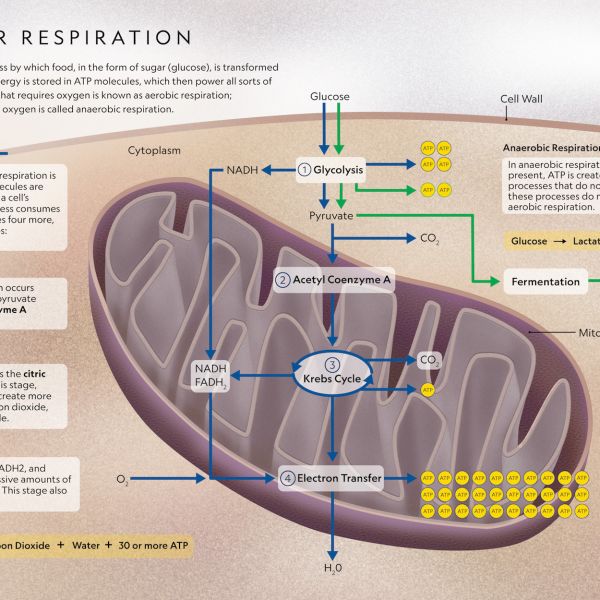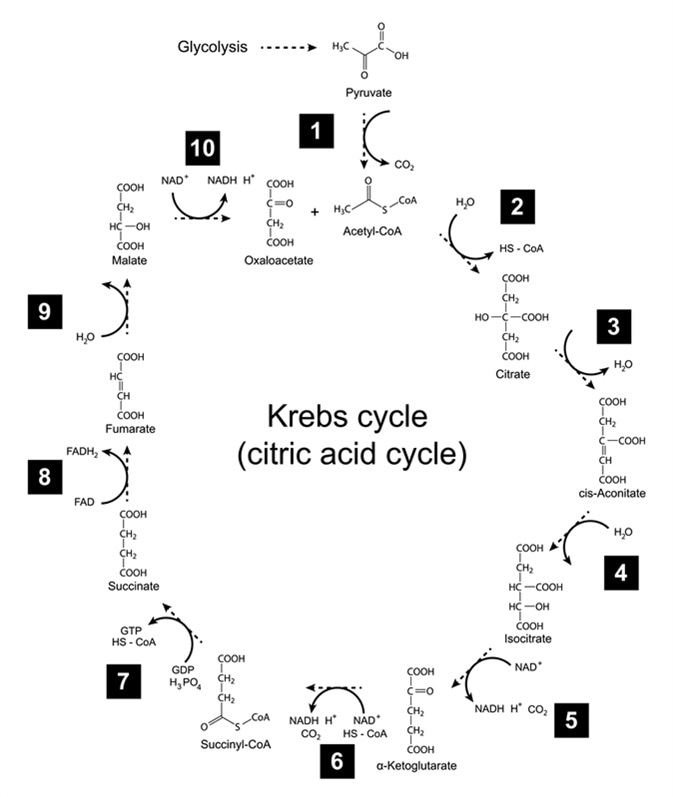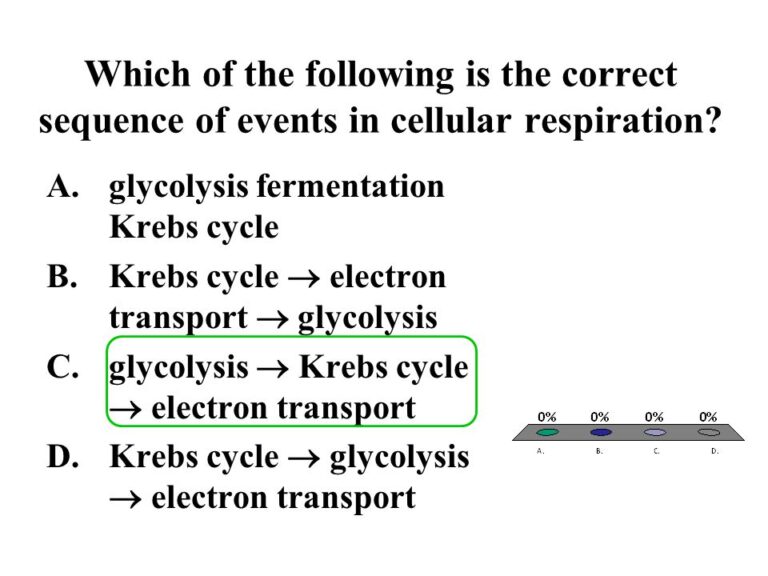Cellular respiration is a fundamental process that provides energy to living organisms by breaking down glucose and other nutrients. Understanding the correct sequence of events in cellular respiration is crucial for unraveling how cells convert food into energy efficiently. The sequence involves several key stages, including glycolysis, the citric acid cycle, and oxidative phosphorylation. By following this intricate sequence, cells can maximize the production of adenosine triphosphate (ATP), the molecule responsible for storing and transferring energy within the cell. Join us as we delve into the specific steps of cellular respiration, shedding light on the fascinating mechanisms that power our biological functions.
Introduction to Cellular Respiration
Cellular respiration is the process through which cells convert nutrients into energy in the form of adenosine triphosphate (ATP). It is a fundamental metabolic process that occurs in both plant and animal cells to support various cellular activities.
The Importance of Cellular Respiration
Cellular respiration plays a crucial role in providing the necessary energy for cellular functions, including growth, repair, and maintenance. Without this process, cells would not be able to survive or carry out essential functions.
Moreover, what is the correct sequence of events in cellular respiration is a common question that helps to understand the intricate steps involved in energy production within cells.
Key Steps in Cellular Respiration
Cellular respiration can be broadly divided into three main stages: glycolysis, the citric acid cycle (Krebs cycle), and oxidative phosphorylation (electron transport chain).
- Glycolysis: This initial stage takes place in the cytoplasm and involves the breakdown of glucose into pyruvate molecules, generating a small amount of ATP.
- Krebs Cycle: The next stage occurs in the mitochondria and further breaks down pyruvate to extract more energy in the form of ATP and electron carriers.
- Electron Transport Chain: The final stage involves the transfer of electrons through a series of protein complexes in the inner mitochondrial membrane to produce the majority of ATP through oxidative phosphorylation.

Glycolysis: The First Stage
Glycolysis is the initial step in cellular respiration, where glucose is converted into pyruvate. This process occurs in the cytoplasm and does not require oxygen, making it anaerobic. Glycolysis consists of a series of enzymatic reactions that break down glucose into two molecules of pyruvate, while also producing ATP and NADH as energy carriers.
Key Steps in Glycolysis
The key steps in glycolysis include:
- Glucose Phosphorylation: Glucose is phosphorylated using ATP to form glucose-6-phosphate.
- Isomerization: Glucose-6-phosphate is converted into fructose-6-phosphate.
- Cleavage: Fructose-6-phosphate is split into two molecules of glyceraldehyde-3-phosphate.
- Energy Production: Through a series of oxidation and reduction reactions, ATP and NADH are produced, resulting in the formation of pyruvate.
The Citric Acid Cycle: Second Stage of Cellular Respiration
The citric acid cycle, also known as the Krebs cycle, is a key component of cellular respiration that takes place in the mitochondria of eukaryotic cells. This cycle is vital for extracting energy from carbohydrates, fats, and proteins in the form of ATP, the cell’s primary energy currency.
Overview of Citric Acid Cycle
The citric acid cycle starts with the entry of acetyl-CoA, derived from the breakdown of glucose during glycolysis, into the cycle. This acetyl-CoA combines with oxaloacetate to form citrate, kicking off a series of enzymatic reactions.
This cycle involves a series of redox reactions that ultimately result in the release of carbon dioxide, the production of ATP, NADH, and FADH2, as well as the regeneration of oxaloacetate to continue the cycle.
Key Steps in the Citric Acid Cycle
1. Citrate Formation: Acetyl-CoA combines with oxaloacetate to form citrate.
2. Isocitrate Formation: Citrate undergoes isomerization to form isocitrate.
3. α-Ketoglutarate Formation: Isocitrate is oxidized to form α-ketoglutarate, releasing CO2 and reducing NAD+ to NADH.
4. Succinyl-CoA Formation: α-Ketoglutarate is further oxidized to form succinyl-CoA, producing CO2, NADH, and ATP.
5. Succinate Formation: Succinyl-CoA is converted to succinate, generating GTP and subsequently ATP.
6. Fumarate Formation: Succinate is oxidized to form fumarate, reducing FAD to FADH2.
7. Malate Formation: Fumarate is further oxidized to form malate, regenerating NAD+ to continue the cycle.
8. Oxaloacetate Regeneration: Malate is oxidized back to oxaloacetate, ready to combine with acetyl-CoA for the next round of the cycle.

Electron Transport Chain and Oxidative Phosphorylation: The Final Steps
As we delve deeper into the correct sequence of events in cellular respiration, we encounter the Electron Transport Chain (ETC) and Oxidative Phosphorylation, the final steps in the process that culminate in the production of ATP, the energy currency of the cell.
The Electron Transport Chain (ETC)
The ETC is a series of protein complexes and molecules embedded in the inner mitochondrial membrane. It is where the majority of ATP is generated during cellular respiration through oxidative phosphorylation.
This process involves the transfer of electrons from NADH and FADH2 along the chain, coupled with the pumping of protons across the membrane, creating a proton gradient.
Oxidative Phosphorylation
Oxidative phosphorylation is the final metabolic pathway of cellular respiration. It involves the phosphorylation of ADP to form ATP using the energy released by the ETC as it transfers electrons.
- The process occurs in the inner mitochondrial membrane.
- ATP synthase plays a crucial role in catalyzing the phosphorylation of ADP to ATP.
- Protons flow back into the mitochondrial matrix through ATP synthase, driving the rotation of the enzyme and facilitating ATP production.
Comparing Aerobic and Anaerobic Respiration
Cellular respiration is the process through which cells convert glucose into energy. Aerobic respiration and anaerobic respiration are two different pathways through which cells can produce energy. Let’s compare these two processes to understand their differences and similarities.
Differences Between Aerobic and Anaerobic Respiration
Aerobic respiration requires oxygen to produce energy, while anaerobic respiration does not. Aerobic respiration is more efficient, yielding a higher amount of energy in the form of ATP compared to anaerobic respiration. On the other hand, anaerobic respiration is faster but produces less ATP.
In aerobic respiration, the final products are carbon dioxide and water, while in anaerobic respiration, the byproducts can include lactic acid or ethanol.
Similarities Between Aerobic and Anaerobic Respiration
Both aerobic and anaerobic respiration involve the breakdown of glucose molecules to produce energy. They both occur in the cytoplasm of the cell. Additionally, both processes go through glycolysis, which is the initial stage of glucose metabolism.
While aerobic respiration takes place in the mitochondria, anaerobic respiration occurs in the cytoplasm. This step is crucial in generating ATP for cellular functions.
Frequently Asked Questions
-
- What is cellular respiration?
- Cellular respiration is the process through which cells convert nutrients into energy by producing ATP (adenosine triphosphate).
-
- What are the main stages of cellular respiration?
- The main stages of cellular respiration are glycolysis, the citric acid cycle (Krebs cycle), and oxidative phosphorylation (electron transport chain and ATP synthesis).
-
- What is the correct sequence of events in cellular respiration?
- The correct sequence of events in cellular respiration is glycolysis, the citric acid cycle, and oxidative phosphorylation.
-
- Where does cellular respiration take place in the cell?
- Cellular respiration takes place in the mitochondria of eukaryotic cells.
-
- Why is cellular respiration important?
- Cellular respiration is important because it provides the energy needed for various cellular processes and activities to sustain life.
Unlocking the Mysteries of Cellular Respiration
As we conclude our exploration into the correct sequence of events in cellular respiration, it becomes evident that this intricate process is crucial for producing energy in living organisms. From glycolysis to the citric acid cycle and finally the electron transport chain, each step plays a vital role in generating ATP, the energy currency of cells.
Understanding the correct sequence of events in cellular respiration not only sheds light on how our bodies function but also highlights the interconnectedness of biological processes. By delving into the intricacies of this metabolic pathway, we gain a deeper appreciation for the remarkable mechanisms that sustain life. Remember, every breath you take fuels a complex series of reactions within your cells!



